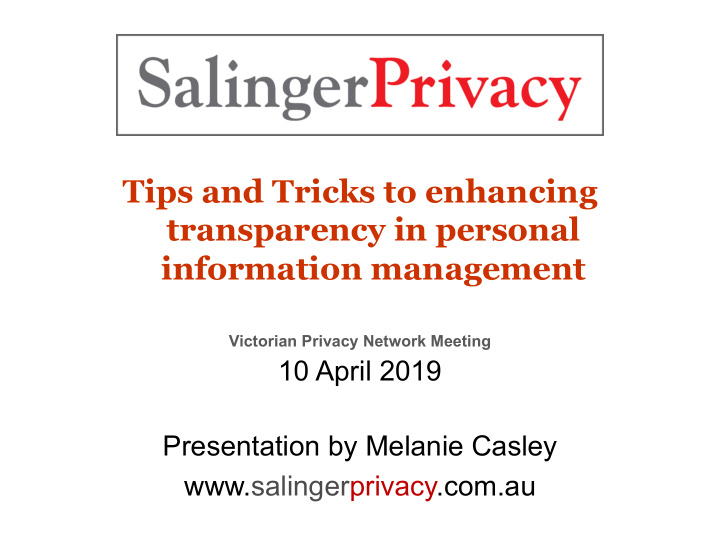



Tips and Tricks to enhancing transparency in personal information management Victorian Privacy Network Meeting 10 April 2019 Presentation by Melanie Casley www.salingerprivacy.com.au
The cause of so much confusion
Back to Basics – Privacy Policies • What are we trying to achieve? • Why are we trying to achieve it?
Tip 1 IPP 5.1: You must have a published Privacy Policy and make it available to anyone who asks for it. IPP 5.2: If asked, you must be able to explain, generally, how personal information is managed.
Trap
Trap
Tip 2 Put yourself in the shoes of your general, target audience
Back to Basics – collection statements • What are we trying to achieve? • Why are we trying to achieve it?
Tip 3 IPP 1.3: Every time you collect personal information, you must take reasonable steps to give notice, specific to that collection. Your Privacy Policy is not a collection notice.
Tip 4 Put yourself in the shoes of the client or individual you are dealing with (and ensure a custom fit!)
Back to basics – Consent • What are we trying to achieve? • Why are we trying to achieve it?
Tip 5 To be valid under privacy law, ‘consent’ must be voluntary, informed, specific, current, and given by a person with capacity. It must be as easy to withdraw consent as to give it. It cannot be a condition of doing business with you.
Trap • A collection notice is not consent. • Your Privacy Policy is not consent. • Clicking on mandatory T&Cs is not consent. • Opt-out is not consent. And don’t confuse your requirement to give notice with your requirement to get consent.
So are we stuck?
Aha! YOU DON’T NEED CONSENT TO DO MOST THINGS. Consent should only be necessary if you are planning to: • collect particular types of data known as ‘sensitive’ information, or • use or disclose data well beyond your primary purpose, and outside your clients’ expectations… and no other exception or exemption applies.
Tip 6 Read the privacy principles! They outline loads of different circumstances in which personal information can be collected used and disclosed, without needing to seek the individual’s consent .
Salinger Privacy blogs More on this topic: • Why you’ve been drafting your Privacy Policy all wrong - July 2018 • Why “opt out consent” is an oxymoron – November 2018 Other popular topics : • Top 10 data breach risks to avoid – February 2019 • Bradley Cooper’s Taxi Ride: a case study on re-identification risks - April 2015 • Individuation and the scope of privacy laws – Aug 2016 • Facebook & Cambridge Analytica – May 2018 www.salingerprivacy.com.au/blog For a regular dose, subscribe to our newsletter!
Salinger Privacy resources • FREE Privacy Officer’s Handbook • Demystifying De-identification : An introductory guide • Big Data : An Ethical Framework for Protecting Privacy • Compliance Kits featuring checklists and template documents (Federal, NSW laws thus far) • Training : customisable eLearning modules, webinars, face-to-face workshops, and IAPP Certification programs • Consulting : PIAs, audits and more www.salingerprivacy.com.au
Thank you Melanie Casley Senior Privacy Consultant, Salinger Privacy We know privacy inside out. We consult, train, publish, blog and tweet on all things privacy. Find out more or sign up for our email newsletter at www.salingerprivacy.com.au
Recommend
More recommend